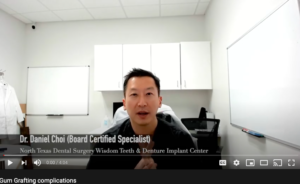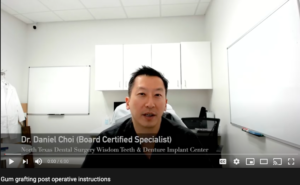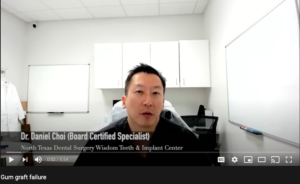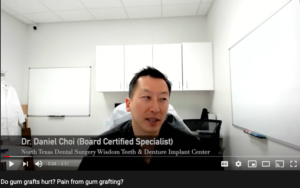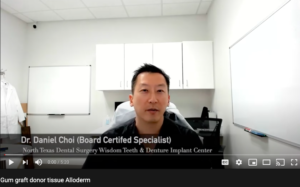Gum Grafting
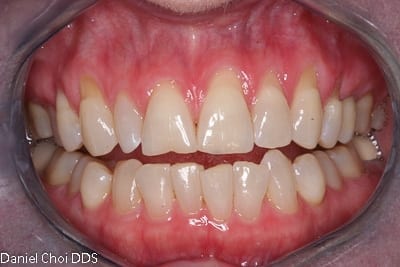
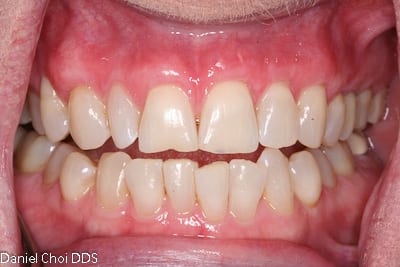
Receding gums, or a receding gum line, is a condition where your gum line is receding away from the crown of the tooth and towards the root of the tooth. This can be a problem because the gums protect your teeth and bone and can be a reason for eventual tooth loss, root cavities, tooth sensitivity, or cosmetic concerns.
Why are receding gums an issue?
Receding gums can cause several unwanted effects. Receding gums can cause:
- Bone loss
- Teeth sensitivity
- Root cavities
Bone loss:
When you lose gums, you lose bone. When you lose bone, you lose gums. This is just the way your bone and gums affect each other. Therefore if you’re losing gums from the recession, then you are losing bone and therefore the support of your teeth
Teeth sensitivity:
Some patients experience teeth sensitivity from cold or hot liquid or food when they experience recession. Although there is nothing significant to be worried about when it comes to sensitivity, it is inconvenient for a patient.
Root cavities:
Root cavities are more likely to occur if you have receding gums. The reason is that your roots do not have enamel which is very resistant to cavities. Root cavities can cause damage to your tooth very quickly and may be more difficult to fill than traditional cavities.
What causes receding gums?
Ever ask “why are my gums receding?” There are many things that can cause gum recession. One of the biggest misconceptions is that aggressive tooth brushing causes gum recession. Although that is possible, it’s not likely. Most cases of recession are cases where particular teeth are involved and not all your teeth.
Major receding gums causes:
- Clenching or grinding
- Orthodontics
- Periodontal disease
- Genetics
- Piercings
Clenching or grinding:
Clenching or grinding your teeth are both considered to be the major cause of gum recession. Although most people aren’t aware that they clench or grind, statistics show that approximately 90% of the population do either at night. Clenching and grinding can cause fractions, which are wedges in your tooth that have been caused by tiny little stress fractures. Avoiding clenching or grinding with the help of nightguards or the use of muscle relaxants such as botox can help alleviate and prevent further damage to your tooth and gums.

Orthodontics:
When moving your teeth around with braces or Invisalign, your teeth roots are moving around within your jaw. Sometimes your roots can be moved to areas of your jaw which have thinner bone and can thus also affect your gums. This problem tends to be more persistent in the front teeth of the lower jaw.
Periodontal disease:
Periodontal disease, or gum disease, is a common cause of bone loss in your mouth. Whenever you lose bone, your gums may also have a tendency to recede because your bone supports your gum.
Genetics:
Your genetics can determine if you’re prone to gum recession or not. Some people have a thick biotype, meaning you have thick bone and gums. Other people have a thin biotype, meaning you have thin bone and gums. People who have a thin biotype have a tendency to have gum recession. Patients who have a thick biotype are more resistant to gum recession and even have a tendency to have gum overgrowth in certain instances.
Piercings:
Piercings of the tongue have a tendency to cause gum recession and bone loss on the tongue side of your lower front teeth. Piercings on the inside of the lower lip have a tendency to cause gum recession and bone loss on the front side of your lower front teeth. Many patients have lost their teeth due to piercings and this can be very costly to fix because oftentimes dental implants may be necessary due to significant gum and bone loss.
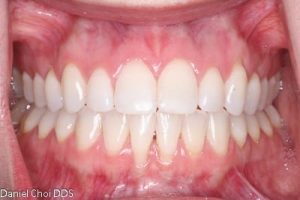
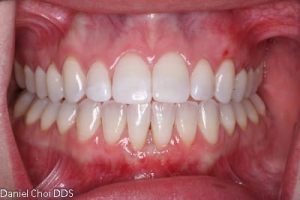
Deep Experience
Over 3,000 successful gum grafts to ensure you have the most predictable outcome.
Specialized Training
Board-certified specialist with advanced training to ensure the work is done right.
Gum Graft in McKinney Plano and Grapevine Texas
A gum graft is a surgical procedure that can help replace the gum tissue that has eroded away. It is a procedure that has a stigma because many people have heard stories of how painful it is. Many advances in the technique in the last 20 years have allowed many patients to experience the benefit of a gum graft without all the pain. The whole purpose of a gum graft is not to always return the gums back to 100% of where they used to be, but more importantly to thicken the tissues so they will at least stop receding any further. 100% tissue growth is always the desired result but is limited by the amount of interproximal bone you have. If you already have bone loss, it is more difficult to achieve 100% tissue growth. The bone between your teeth, referred to as the interproximal bone, serves as the blood supply for your gum graft and therefore dictates how successful your grafting procedure should be. It is of utmost importance to perform the gum grafting procedure before your recession and bone loss is so severe that it compromises the result you could have had had you done the procedure a few years earlier.
Receding gums treatment
If you’re wondering how to fix or stop receding gums, there are two major forms of gum graft surgery. These techniques can be used to reverse receding gums. One is called the free gingival graft. The other is called connective tissue grafting. There is a third technique called the pinhole technique which is a modification of the connective tissue graft. All of these different surgical options are also available with IV sedation to ensure a comfortable experience.
Free gingival graft:
This is an older form of gum grafting technique. This involves removing the surface layer of tissue from the roof of the mouth and transplanting it to the area where your gums are receding. It is not an as effective a technique to treat receding gums as the connective tissue graft and is more effective at preventing further gum loss. This procedure tends to be more painful for the patient than the connective tissue graft. This procedure is more likely to be used to treat lower front teeth.
Connective tissue graft:
This is the most effective treatment option for treating receding gums. It is much less painful than a free gingival graft because it involves using the middle layer of tissue from the roof of the mouth. Also with this procedure, you have the option to use human donor tissue as the donor tissue, instead of using your own roof of your mouth. There are many variations of this technique that allow for a much less invasive technique that allows superior results and less pain.
Pinhole technique:
This is a combination technique of the connective tissue graft using a less invasive pouch or tunneling technique but from the other side of the gums referred to as a “pinhole” and using human donor tissue.
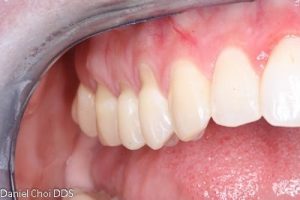
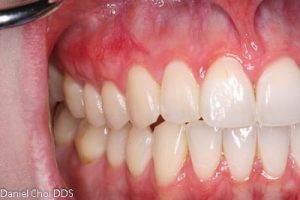
“I think Dr. Choi is very welcoming, very knowledgeable, I think he might be the best at what he does, he has empathy … He’s 5 star”
“Dr. Choi was friendly, helpful, and very professional. The offices are beautiful and clean, the staff is all amazing and informative. Had a question about my procedure late on the first day, texted the office a question, and Dr. Choi called personally minutes later to answer any concerns. In my experience everyone, there was highly interested in their patient’s well-being. I highly recommend this business!”
“Highly recommend. Dr. Choi is personable, quick, and efficient. The staff is very cheerful and keeps everything running smoothly and efficiently.”
Gum Graft Pain
Does gum grafting hurt? That’s the most common question patients ask when gathering information about the procedure. During the procedure, you should not feel any pain. The surgeon will numb you before the actual procedure starts so you should not feel anything throughout the procedure. Some surgeons will also give you the option of IV sedation which will allow you to sleep through the procedure and not remember anything. Pain from gum grafting is more likely to occur during the recovery phase from the procedure.
Gum graft recovery
The recovery for gum graft varies significantly between a connective tissue graft and a free gingival graft. The free gingival graft has a reputation for being more painful throughout the healing process while the connective tissue graft is not. Keep in mind your dental surgeon will provide you with pain medication after the procedure.
Free gingival gum graft recovery timeline:
The first few days are typically marked by a significant amount of soreness especially from the roof of the mouth, but also from the recipient site. Patients typically say the pain is anywhere from a 4 to 6 on a scale of 1-10. Patients typically tend to complain more of the pain from the roof of the mouth and it usually lasts anywhere from a few days to a week.
Connective tissue gum graft recovery timeline:
Patients may typically experience some swelling in the first few days after the surgery when having a connective tissue graft. This may be a source of some discomfort. This can be minimized with the use of some steroidal anti-inflammatories such as a Medrol dosepak when it is started approximately 24 hours before your procedure. If you do experience swelling, it usually subsides after only a few days. More of the discomfort from the procedure mainly comes from the roof of the mouth but it is not nearly as painful as the free gingival graft. This is due to the donor tissue coming from the middle layer of the roof of the mouth and not the surface layer as seen in the free gingival graft. Overall, patients usually describe the pain as being approximately 1 to 2 on a scale of 1-10.
Gum graft post-op and recovery instructions
In order to properly recover from a gum grafting procedure, it is very important that you follow your post-operative instructions. A gum grafting procedure is essentially transplantation. It is very important that the tissues be immobilized and not allow any movement of the gums in the area of the gum graft. Allowing any excessive movement of the area can cause gum graft complications. Excessive movement can be caused by not being careful with dietary restrictions and not being careful of how you brush your teeth after the procedure. The longer you can follow these instructions, the better your graft will heal. The results of the procedure are not the only contingent on having an excellent surgeon, but also rely on you taking good care of your mouth during your healing period.
Gum Graft Healing stages
Days 1-4: Typically the first few days are marked by some swelling on the graft recipient site, especially with a connective tissue graft or pinhole graft. During this time your roof of the mouth may have some bleeding, especially with a free gingival graft.
Days 5-7: This is the period of further integration of your graft into the recipient site. It’s usually at this point where you can tell if a graft is going to be successful or not. The roof of the mouth continues to heal and usually becomes less tender by this point.
Days 7-14: Again, this is a period of further integration of your graft. It’s at this point that the stitches that are holding the graft in place can be removed from a free gingival graft. The roof of the mouth usually should no longer be sore by the 14-day mark.
Days 14-28: Your graft recipient site still continues to heal on the cellular level. It is best to have your surgeon remove your sutures around the 1-month mark for a connective tissue graft. The roof of the mouth should be completely healed by now with no discomfort at all.
Days 28+: Your tissues still continue to heal and esthetically they start to blend in with the surrounding tissues.
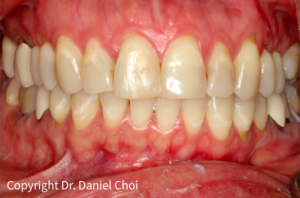

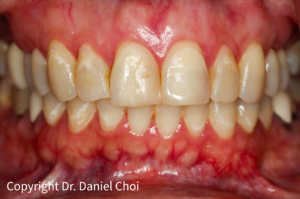

Gum Graft Failure
Gum graft failure is not uncommon as it is a very technique-sensitive procedure and should typically only be done by a periodontist who has had years of training in a residency. How do you know if a gum graft has failed? You would typically see a large white patch of gum that is hanging outside of your graft recipient area. This could happen because the gum graft tissue from the roof of the mouth or the donor tissue had become destabilized from the recipient area. This is not uncommon. Usually, when you see this large white patch of gum, this is the telltale sign of gum graft failure. The gum is white because it has died and has failed to receive vascularity from the surrounding tissues. If this is the case, the procedure would have to be reattempted in the future after at least 3 months of healing.


